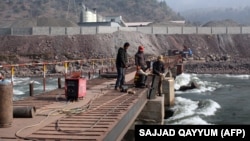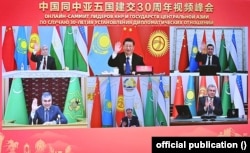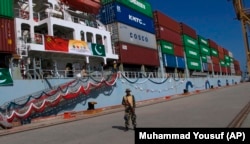A few weeks before the Sri Lankan president fled the country amid growing protests triggered by its debt-laden economy’s default and financial crisis, a top Kyrgyz official issued a warning about the Central Asian nation’s own dire forecast as the turmoil unfolded.
“We must always remember the need to pay [our] public debt,” Akylbek Japarov, the chairman of Kyrgyzstan’s cabinet of ministers, said at a parliamentary session in late June.
Like Sri Lanka, Kyrgyzstan also has a swelling state debt and took on billions worth of loans over the last decade from China’s Export-Import Bank for a series of infrastructure plans under the Belt and Road Initiative (BRI), Chinese leader Xi Jinping's signature policy, which he once dubbed “the project of the century.”
Kyrgyzstan’s debt currently sits north of $5.1 billion, according to the Foreign Ministry, 42 percent of which is owed to Beijing. But Bishkek is struggling to cope with a contracting economy and has so far failed to yield a commercial return on the projects backed by its huge Chinese loans. This has prompted fears the country will be unable to pay off its loans or even meet interest payments. The mounting financial pressure has also raised concerns that the country may have to hand over lucrative assets if it fails to meet its repayment obligations.
“I’m not scaremongering, but if we do not pay this debt, [China’s] Export-Import Bank can take over [projects]. This has already been [discussed] in cases in Pakistan, Sri Lanka, and other countries,” Japarov said. “We cannot sit back and rely only on [God]. We all need to unite in order to maintain our independence.”
That warning comes as sovereign-debt distress spreads in several countries along the BRI, prompting China’s first overseas debt crisis as it grapples with a mounting pile of nonperforming loans and increased scrutiny of how Chinese lending has exacerbated economic pressures on vulnerable governments.
“There’s no doubt that the Chinese Ministry of Finance and central bank are looking at their dashboards and their red lights are going off right now,” Bradley Parks, executive director of the AidData Lab at the College of William and Mary in Virginia, told RFE/RL.
The globe-spanning scale of BRI, which was launched in 2013 by Beijing as the largest infrastructure program undertaken by a single country, has left it with a list of risky debtors around the world -- including Argentina, Pakistan, Russia, Tajikistan, Venezuela, Zambia, and Iran -- that hoped to take advantage of the surge in Chinese overseas lending but now find themselves struggling with a debt crisis the World Bank has warned could trigger a series of defaults not seen since the 1980s.
For China, this marks what analysts describe as a crucial inflection point after nearly 10 years of runaway lending under the guise of the BRI that has been exacerbated recently by rising inflation, soaring energy costs, and tightening global financial conditions due to the war in Ukraine and the aftermath of the COVID-19 pandemic. In such an environment, Beijing could be looking to streamline and scale back its hallmark initiative.
“China is growing more concerned about it not being able to get paid back, so we have seen a pullback in lending that is set to accelerate,” Alicia Garcia-Herrero, the chief economist for Asia-Pacific at the investment bank Natixis, told RFE/RL. “China is also under growing economic pressure at home now and is becoming more hesitant to lend to risky countries. [This] has [opened] a new phase of the BRI.”
Growing Debt Pressure
The BRI has helped make China the world’s largest bilateral lender and seen it give out loans totaling $932 billion since it was established eight years ago, according to data collected by the Green Finance and Development Center at Fudan University in Shanghai.
But even before the current debt crisis, the headwinds against the BRI were mounting.
Loans issued in recent years are turning bad at an unprecedented rate, with research by Rhodium Group, a New York-based research consultancy, showing that the value of Chinese loans that required negotiation soared to $52 billion in 2020 and 2021, a threefold increase from the previous two years.
Data compiled by William and Mary’s AidData Lab, which maintains one of the most comprehensive datasets on Chinese development finance, also shows the current scale of the debt crisis, with its research indicating 60 percent of Chinese loans are to countries in financial distress, compared to only 5 percent in 2010 before the BRI was launched. Other research by AidData shows that 35 percent of the BRI infrastructure projects currently face major implementation problems.
In the face of such pressures, Beijing has begun to issue so-called “rescue loans” to starve off defaults, with AidData showing that tens of billions of dollars have been issued by Chinese state institutions to countries such as Pakistan, Belarus, Egypt, Mongolia, Turkey, and Sri Lanka, to help service their loans and avoid default.
“We are at a major pivot point right now. The scale of this widespread debt pressure is something that China has never faced before and it is having to reinvent BRI on the fly,” Matthew Mingey, senior research analyst at Rhodium Group, told RFE/RL.
A July report from the Green Finance and Development Center showed how the BRI is becoming more risk-averse, with new investment in Russia, once a mainstay of the initiative, falling to zero in the first half of 2022, while engagement in Pakistan dropped by 56 percent during the same period.
China is increasingly investing in oil and gas, making up about 80 percent of Chinese overseas energy investments for the first half of 2022 and 66 percent of Chinese construction contracts, with Saudi Arabia being the top recipient.
Christoph Nedopil Wang, the director of the center behind the report, told RFE/RL that Beijing is increasingly targeting resource-backed investments as they present a “more straightforward way” for Chinese institutions to be repaid compared to large-scale infrastructure projects.
According to Mingey, the spreading debt distress coupled with slowing global growth and a more cautious approach from Beijing means that China will need to search for new ways to solve the problem at hand. Rescue loans are a time-buying measure and in the case of Sri Lanka, they still failed to offset a default. The big question, he says, is to what extent Beijing will participate with multilateral institutions in debt resolution programs in BRI countries.
“Previously, the playbook was simple: It was to defer, restructure, and give space and time for borrowers to sort things out,” Mingey says. “But China has an aversion to refinancing, and Chinese creditors have not always played well with multilateral institutions, private creditors, or public bilateral ones. So, it's a question of what tools China can use now.”
The Road Ahead For Bishkek, Islamabad
Chinese loans are not the sole cause of debt distress or defaults. Sri Lanka has international debts of more than $50 billion, with only about $5 billion owed to China.
But Beijing’s lending to the South Asian country has been controversial, with critics arguing that credit for projects has been extended at high rates and money from the glut of foreign borrowing is being misused, amid accusations of corruption.
Similar allegations have dogged BRI-backed projects in Kyrgyzstan and Pakistan.
In the case of Pakistan, the country of 220 million people is the biggest single recipient of BRI financing worldwide and hosts the $62 billion collection of infrastructure projects known as the China-Pakistan Economic Corridor (CPEC).
Similar to Sri Lanka, the viability of some projects have been brought into question in Pakistan, including a port project in Gwadar along the strategically important mouth to the Strait of Hormuz, which has often been trumpeted as a BRI priority.
But tensions over the implementation of BRI projects has strained relations for both Beijing and Islamabad. Still, Beijing has issued a string of loans aimed at averting a default, with a consortium of Chinese state banks lending $2.3 billion to Pakistan in late June.
Beijing has reportedly urged Islamabad to repair ties with the IMF and resurrect a loan program agreed in 2019, of which the fund has so far given only about half of the agreed $6 billion sum.
Pakistani Finance Minister Miftah Ismail told Bloomberg on August 1 that progress had been made on the loan, which could stave off a default, but analysts say Islamabad’s finances remain strained, and Mingey said that Pakistan is still a leading “domino to fall” after Sri Lanka amid the debt crisis and possibility of further defaults.
Kyrgyz officials have spoken about the urgency of making their payments to China and say they are capable of meeting their obligations to foreign creditors, with President Sadyr Japarov promising not to delay foreign debt repayment even for “one hour.”
Japarov warned about the consequences of not meeting its debt payments to China in 2021, with discussion around the handing over of the rights of the Jetim-Too iron ore mine to Chinese firms as one avenue to resolve a dispute. Japarov has since said that the mine will be developed locally, but the possibility of a Chinese takeover still hangs over the project, as does other Chinese-financed projects such as the Bishkek thermal power plant, which could be placed under external management if Kyrgyzstan does not pay off its debts on time.
Navigating A New Crisis
One of the unique dimensions to the current debt crisis that analysts say raises the stakes is China’s relative inexperience and the lack of precedence in dealing with such issues.
For more than 60 years, sovereign-debt restructurings have been coordinated by the Paris Club, an informal association of 22 mostly Western major creditor countries. Created in 1956, the group has signed hundreds of agreements across the world, often working with the IMF.
China is not a member of the Paris Club and only became a major creditor nation in the last two decades, as the BRI helped catapult its status as a leading lender.
AidData’s Parks says that little is known about how Beijing will approach its role as an important creditor in a time of growing distress, but that China has frustrated restructuring efforts in the past, which often involve compromises and pain for both borrowers and lenders -- and will also require them to work other international creditors who are owed outstanding debts from the same countries.
“Every successful sovereign-debt restructuring has happened when all creditors have taken a haircut and structured agreements so that no one creditor bears a disproportionate burden,” Parks said. “We’re waiting for the precedent to be set here with China and its restructuring.”
A hint of how China could approach this issue will be seen in how Beijing resolves this in Sri Lanka, Zambia, Laos, Cambodia, and Ethiopia, which are now restructuring their debts with China and creditors like the World Bank and IMF.
On July 30, China announced that it had agreed to provide debt relief to Zambia, which paves the way for a future IMF bailout in a potentially precedent-setting move for how Beijing will work with other lenders under the so-called Common Framework for debt treatments agreed by the G20 in late 2020.
“As originally conceived, BRI cannot sustain itself according to that original vision, but we shouldn’t underestimate the Chinese,” said Parks. “They are quite strong at learning and adapting to their past mistakes.”












